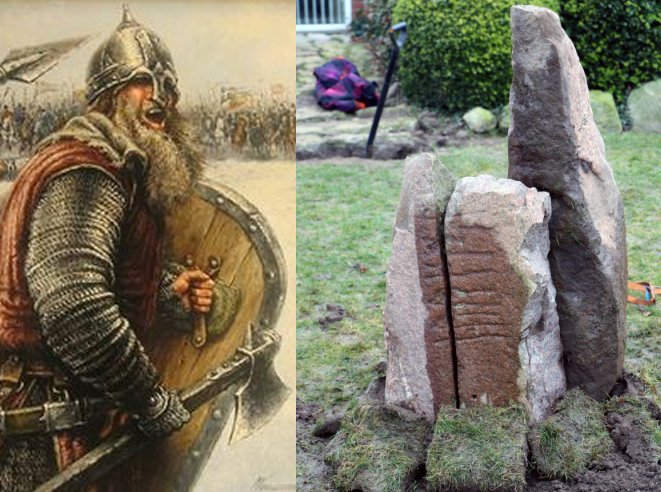30 Great Archaeological Discoveries In Scandinavia 2016
– 2016 was a very successful year for archaeologists excavating in Scandinavia. Several remarkable ancient findings were made in the Nordic countries. Some of these ancient discoveries helped to solve ancient mysteries, but other intriguing findings have raised new questions and revealed there is still a lot we don’t know about ancient Scandinavian history.
Scientists have found mysterious ancient artifacts, new clues about Vikings, puzzling ancient graves, unusual symbolic petroglyphs, “magical” ancient objects, missing rune stones and much more. We have put together a list featuring the most intriguing archaeological discoveries made in Scandinavia last year.
A large Viking treasure has been discovered in a 3,000-year-old grave in Sweden. The treasure was hidden sometime at the end of the Viking Age and consists of 163 silver coins with Arabic inscriptions. It is the largest Viking treasure ever discovered in Uppland, a county on the eastern coast of Sweden.
Swedish archaeologists are currently conducting excavations in Molnby in Vallentuna as preparation for the construction of a new railroad and they were lucky to uncover an ancient 3,000-year-old grave in the area.
When they removed soil and opened the grave, they discovered a precious Viking treasure. Someone decided to hide the treasure inside the grave about 1,000 years ago, but why is not entirely clear. Read more
An ancient rune stone from Thy, Denmark has been missing for 200 years. Over the years archaeologists have made several attempts to locate the unique, thousand-year-old stone, but without any success. Not until now. Fragments of the stone have been discovered on a farmer’s garden terrace in Thy. Read more

Archaeologists excavating in Sweden made an exciting discovery when they found a very unusual and rare ancient Viking era coin. The coin was found outside in a ditch outside the town of Linköping, Sweden. The silver coin was produced in the early 1oos and can be traced to England. This part in Sweden was known far having contact with the Englishmen during the Viking era. Read more
mateur archaeologists in Denmark have made a remarkable discovery excavating in a field in Jutland. They found Denmark’s largest Viking gold treasure consisting of several beautiful bracelets weighing a total of almost one kilogram (2.2. pounds). This is a truly astonishing discovery since most Viking hoards consist of silver artifacts. Read more
An amateur archeologist in Finland has made an extraordinary discovery of a three-headed eagle pendant on the Pohdonsaari Island. The pendant is from the Iron Age and most likely a ritual object. The eagle’s three heads may represent three different human souls, according to archeologists who are currently examining this unique find.
Although, Reijo Hyvönen has previously discovered many valuable ancient objects with help of his metal detector, this recent discovery made him more or less speechless. Read more
While documenting already existing petroglyphs on the Himmelstalundsfältet outside the town of Norrköping, Sweden, scientists came across new previously unknown ancient rock carvings.
Some of the new petroglyphs have symbolic and religious meaning. The Sun symbol played an important role to Bronze Age people and thus the object is frequently encountered on ancient carvings.
Other rock petroglyphs depict ships, bowls, sun crosses and a human being. Read more
A unique 1,000-year-old Viking sword has been accidentally discovered in Iceland. The ancient sword is very well-preserved and was found in in Skaftárhreppur, south Iceland, a region badly hit by floods last year.
This double edged sword was found by hunters tracking geese in the wilds of southern Iceland. The sword is slightly curved at the point and due to years of exposure the metal blade has partially corroded.
But despite years out in the open, splinters of wood can still be observed around the handle. The extraordinary discovery has been handed over to the Cultural Heritage Agency of Iceland, who described it an exciting Viking find and speculate it may have come from a previously undiscovered settlement or grave. Read more
A small figurine of a horned Odin was discovered by a metal detector in Denmark and of course it raises questions whether Vikings maybe did wear horned helmets after all, but the answer is – no they didn’t. Viking helmets with horns have never existed. It’s a pure myth not based on real facts. So, why is Odin depicted with horns? Read more
The original shrine to a Viking-king-turned-saint has been discovered in Norway, archaeologists say.The Norwegian Institute for Cultural Heritage Research (NIKU) announced Nov. 11 that its researchers had discovered the foundations of a wooden church where the body of King Olaf Haraldsson was taken immediately after he was declared a saint in 1031.
St. Olaf, as he is now known, conquered and consolidated Norway in 1016 but held on to rule for a little more than a decade before his power was threatened by Canute I, king of Denmark and England. Olaf died in the Battle of Stiklestad in 1030.Now, archaeologists say they’ve found a key location in the king’s posthumous journey from martyr to Norway’s patron saint. Read more
Archaeologists have discovered a large amount of ancient amulet rings at Gamla Uppsala, one of the most important, sacred ancient Viking and Pagan sites in Sweden.
The ancient rings are covered with intriguing magical designs and believed to have been used as ritual objects. Read more
An important 1,000-year-old Viking rune stone made by Fot runemaster has been discovered in Sweden. The rune stone has been missing for two centuries and was finally found by pure chance not far from Uppsala, a sacred Viking and Pagan site. The Swedish rune stone was discovered during installation work of a lightning conductor at Hagby Church, west of the central Swedish university town of Uppsala. It was found underground a few metres from the building. The rune stone is well-preserved, but one piece is missing so not all the inscriptions can be deciphered. Read more
Archaeologists have found a spectacular, 5,000-year-old stone map on Bornholm.
The stone is filled with lines that look like rays, but it is not a star map. It is something else.
The find was made during archaeological excavation work at Neolithic shrine Vasagård where scientists have previously unearthed similar ancient stones inscribed with rectangular patterns filled with different rows of lines and shading. Read more
Archeologists who specialize in excavation in Northern Scandinavia have unearthed ancient artifacts of the Sami People.
The discovery was made in Lappland, a province in northernmost Sweden. According to archaeologists it is global warming and much warmer summers that have contributed to the melting of the snow and thus made it possible to find artifacts that have remain hidden for thousand of years. Read more
Skagafjörður is a deep bay in Iceland. It’s a place of great archaeological interest and researchers have been excavating here for many years. Over the years, scientists have found several intriguing ancient objects.The recent discovery consists of unique 1,000-year-old artifacts, skeletons and remains of a fairly large church. As many as 45 ancient graves in a circle formed churchyard, with a number of skeletons in various shapes of decay. Read more
A unique Viking tomb with rare remains of powerful couple has been unearthed in Denmark.
The tomb, located in south west Denmark is part of large burial. Archaeologists are calling the tomb a Viking death house (‘dødehus’).
The building measures four by thirteen meters and contained three graves dating back to 950 CE.
Soil conditions at the site have prevented the preservation of any other remains, but the finds in the tomb confirm that there was a man and a woman in the main part and another man in the back. Read more
This unique, ancient symbol of power is on display for the first time ever. The artifact, in form of a raised fist was discovered in the vicinity of Raseborg Castle in the village of Snappertuna, Finland. It is believed an influential person lost his power of symbol and never found the artifact again.
A similar artifact has never been found anywhere in Finland.
According to Dan Lindholm, director of the Ekenäs Museum, only a few selected individuals were allowed to carry a true symbol of power like this one.
Lindholm point out it is possible the raised fist that dates back to the year 1450 was also used in battle.
Similar fists have been unearthed in Estonia and Bohemia, a region in the Czech Republic. Read more
n ancient human skeleton discovered in the bottom of an abandoned castle well in Trondheim, Norway confirms dramatic historical events mentioned in Norse Sagas.
Sverres Saga is a Norse Saga written about 1170 by an Icelander called Eiríkr Oddsson. The stories deal with several 12th century kings of Norway, but of course the main subject is subject is King Sverre Sigurdsson of Norway (r. 1177–1202).
It is one of very few historical manuscripts describing events in the Norwegian Viking age and medieval period and scientists have often questioned the chronicle’s trustworthiness as a historical document.
However, skeleton provides enough evidence that at least one part of the saga seems to hold truth, down to the tiniest detail. Read more
A Viking-age (9th/ 10th century) woman grave was discovered at Ketilsstaðir, eastern Iceland, in 1938. Her skeleton was very poorly preserved and incomplete.The woman from Ketilsstaðir wore typical copper-alloy Scandinavian oval brooches, one of which was in direct contact with her face, resulting in significant soft tissue and textile preservation.
More Archaeology NewsNow, researchers say that the unknown woman buried with Viking-era objects, was a child of some of the island’s earliest settlers, researchers say. Tooth development and wear suggest she was between 17 and 25 years old when she died. Read more
A gold pendant depicting the Norse God Odin and his horse Sleipnir has been discovered on a farm in Kungsbacka, Sweden. Archaeologists think the precious jewelry can be linked to the Heruli, the Huns and ancient Romans.
The Heruli were an East Germanic tribe that lived near the Sea of Azov, near the Black Sea, in the third century AD, and later moved to the Roman frontier on the central European Danube at the same time as many eastern “barbarians” during late antiquity, such as the Goths, Huns, Scirii, Rugii and Alans. Read more
An amateur archaeologist in Denmark has made the discovery of his life.
While searching for ancient artifacts with his metal detector he came across a beautiful, small 1,100-year-old golden crucifix. The artifact is older than the Jelling Stones and can therefore help to re-write the history of when the Danes really became Christians.
The inscription on the Jelling Stones states King Harald Bluetooth made the Danes Christian. Bluetooth became known for casting off the Norse pagan traditions and, becoming a devout Christian who strove to peacefully convert the people of Denmark during his rule. Read more
9,000-year-old fish bones discovered in southern Sweden provides earliest evidence of fermentation for food preservation anywhere in the world.
The discovery of the world’s oldest storage of fermented fish in southern Sweden provides earliest evidence of fermentation of food and could rewrite the Nordic prehistory with findings indicating a far more complex society than previously thought.
The unique discovery was made while excavating a 9,200 year-old settlement at what was once a lake in Blekinge, in southern Sweden. Read more
Archaeologists excavating in the city of Linköping, Sweden have made a unique discovery. Inside a 1,000-year-old grave they found the body of the last Viking who lived in the city.
Who the Viking actually was is unknown, but he was buried along with an axe, work tools, and an odd metal plate that has not yet been identified.
What is unusual about this discovery is the Viking was buried in one of the early Christian graves at St Lars Church and was given sacrifices. It shows that he died and was buried during times when Christianity was not yet widespread and the Viking traditions had not yet disappeared. Read more
Archaeologists excavating in Sweden, just outside Fröshult in the county of Uppsala have discovered a number of mysterious medieval graves and a place of sacrifice with many ancient artifacts that were deliberately placed there to appease Goddess Frey.
In Norse mythology, Goddess Freya was the goddess of love, fertility and beauty. It was believed that she also practiced a powerful kind of witchcraft which could manipulate one’s destiny.
Archaeologists have been excavating in the area for some years and made several interesting discoveries that shed more light on the ancient beliefs of people. Read more
Almost 2,000 years ago, a devastating fire destroyed this Iron Age home near Viborg in West Denmark.
Now, a team of archaeologists led by Mikkel Kieldsen, an archaeologist with Viborg Museum, Denmark, will try to shed some light on the history of this house and people who lived there. Archaeologists do not know whether the house fire was an accident or if it was started deliberately. However, scorched layers of earth have protected the site for almost two millennia and will probably help to answers many questions. Read more
A 1,500-year-old golden amulet with a runic inscription have been found in a field at Magletving on Lolland by a father and his two sons. The amulet (or bracteate) is a small, round, thin golden disc with a decorated front that is framed by a gold thread. It has an eyelet for a cord or chain, so it could be carried around the neck. Archaeologists have determined that the image on the amulet most likely depicts Odin, the king of the gods and the deity for war and death; there is namely, a small runic inscription with the words ‘The Tall’, which was one of Odin’s nicknames. Read more
The two discovered artifacts do not appear very exciting at first glance, but they are highly significant. These two 2,000-year-old objects have now been examined by experts who concluded history of metallurgy in Northern Sweden must be rewritten.
It was long believed that knowledge of metallurgy did not reach Northern Sweden until the 17th century, but the two artifacts currently kept at the Museum of Norrbotten offer evidence people in this part of the country were familiar with metallurgy 2,000 years ago. Read more
Researchers discovered the oldest known stationary fish traps in northern Europe off the coast of southern Sweden. Later investigations showed traces of a 9,000-year-old underwater site.
Many quickly labeled the submerged site a “Swedish Atlantis”. However, this submerged ancient settlement is in no way related to the lost legendary continent of Atlantis.
Nevertheless, the underwater site is still very intriguing and offers many clues to how our ancestors lived as well as what kind of environmental changes they were facing. Read more
Vallø Borgring”, a unique circular Viking Age fortress in Denmark is still an unsolved chapter in the Viking history.
Archaeologists have for many years excavated at the site trying to get a better understanding of what exactly took place at Borgring. We know that the fortress was deliberately set on fire by someone on the outside, but who did it, is still unclear.
Using metal detectors, a group of amateur archaeologists have now discovered a 1,000-year-old Viking toolbox that can cast more light on this ancient Viking mystery.
The ancient box was found near to the fortress’ east gate. It was hidden under a lump of soil. Read more
Once a political and military center of power and legendary kings, Vordingborg is an impressive castle in Denmark located on the southern coast of Zealand facing across the Baltic Sea towards Germany.
Vordingborg is Denmark’s’ the biggest royal castle. It was long thought that the castle was built in the 12th century by King Valdemar the Great.
King Valdemar the Great used it as a base for raids on Germany and, later under Valdemar’s son Valdemar II the Victorious, Estonia.
During the 14th century, the castle was expanded by the third Valdemar, Valdemar the Younger.
The three Valdemars have since been considered the original lords of the castle and given credit for making it one of the most impressive sights in the country.
However, recent archaeological discoveries put the record straight and force us to re-write the castle’s history and put King Canute VI in the spotlight instead of the King Valdemar the Great and his sons. Read more
Surrounded by beautiful large, deep lakes such as Lake Hornavan, Lake Uddjaur and Lake Tjeggelvas, the Arjeplog’s mountain archipelago offers visitors astonishing scenery and archaeologists a wealth of information about our distant past.
About 20 unique between 4,000-6,000-year-old petroglyphs linked to an ancient ritual site have been discovered in Arjeplog Mountains, Sweden. An analysis of the ancient Swedish petrogyphs has been made and the results are startling. Read more



 Creators of mankind
Creators of mankind Description of “Tall white aliens”
Description of “Tall white aliens” Where they came from?
Where they came from? About hostile civilizations
About hostile civilizations The war for the Earth
The war for the Earth “Tall white aliens” about eternal life
“Tall white aliens” about eternal life Video: “Nordic aliens”
Video: “Nordic aliens” Aliens
Aliens Alien encounters
Alien encounters The aliens base
The aliens base UFO
UFO Technology UFO
Technology UFO Underground civilization
Underground civilization Ancient alien artifacts
Ancient alien artifacts Military and UFO
Military and UFO Mysteries and hypotheses
Mysteries and hypotheses Scientific facts
Scientific facts


















